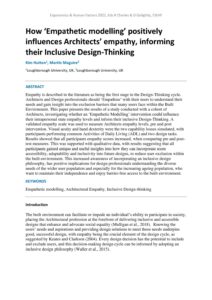| Document | Author Kim Hutton and Martin Maguire |
| Abstract Empathy is described in the literature as being the first stage in the Design-Thinking cycle. Architects and Design professionals should ‘Empathise’ with their users to understand their needs and gain insight into the exclusion barriers that many users face within the Built Environment. This paper presents the results of a study conducted with a cohort of Architects, investigating whether an ‘Empathetic Modelling’ intervention could influence their intrapersonal state empathy levels and inform their inclusive Design-Thinking. A validated empathy scale was used to measure Architects empathy levels, pre and post intervention. Visual acuity and hand dexterity were the two capability losses simulated, with participants performing common Activities of Daily Living (ADL) and two design tasks. Results showed that all participants empathy scores increased, when comparing pre and post-test measures. This was supported with qualitative data, with results suggesting that all participants gained unique and useful insights into how they can incorporate more accessibility, adaptability and inclusivity into future designs, to reduce user exclusion within the built environment. This increased awareness of incorporating an inclusive design philosophy, has positive implications for design professionals understanding the diverse needs of the wider user population and especially for the increasing ageing population, who want to maintain their independence and enjoy barrier-free access to the built environment. |

